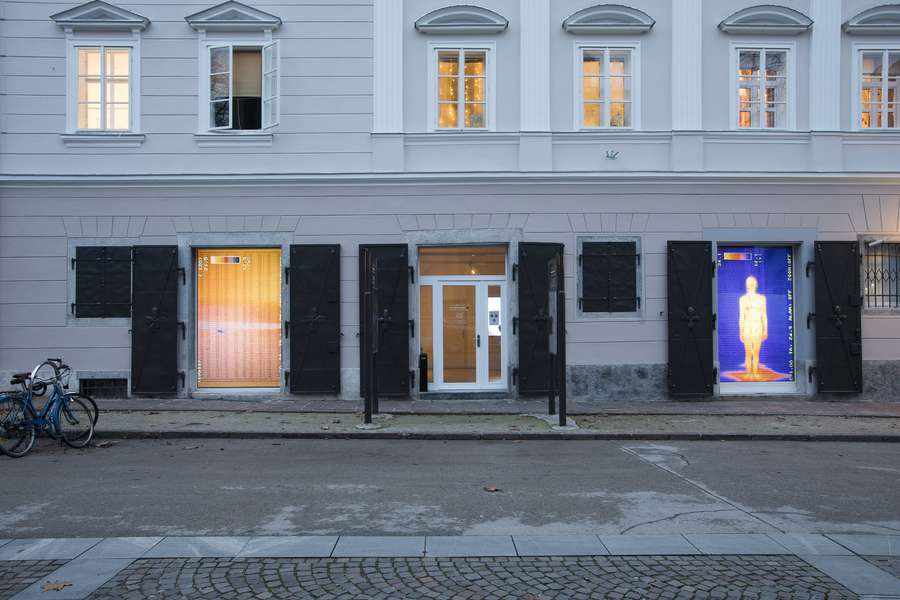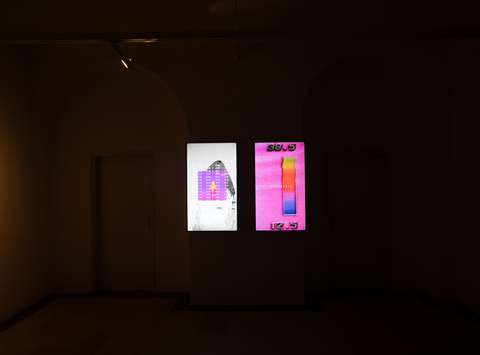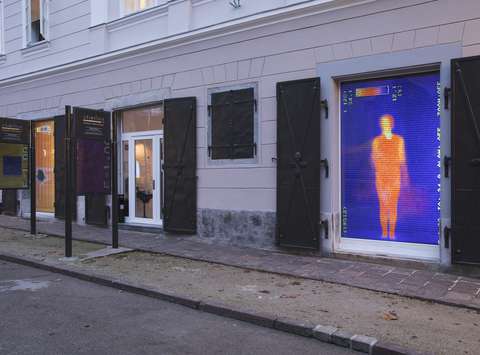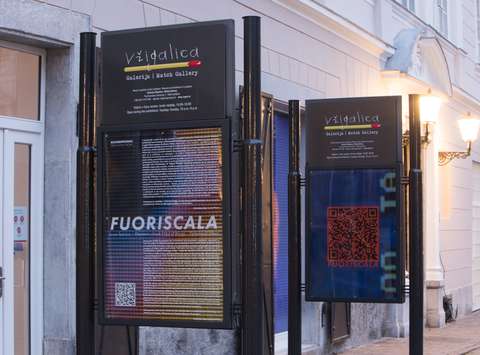Fuoriscala
Video installation in the display windows of the gallery can be viewed each day from 16:00 to 8:00.
Athropocene is the era in which we live, and the data we collected show that things are already out of range. Things are out of control, they are "fuoriscala".
During the COVID-19 pandemic the circumstance and quarantine regulations separated us from the places of cultural production and presentation. But in spite of the conditions and procedures that have been enforced, it is essential that we keep and nourish the physical presence of culture spaces and society.
Fuoriscala was born in specific circumstance and problematises a global challenge, which – while the attention of the worldwide public is focused on a single common global problem that seems to have phisically affected all of us – has not disappeared.
Video installations produced by the artistic collective Bastardprodige (Atej Tutta, Valeria Cozzarini) specifically for this occasion, explore a bigger and more long-term global challenge, the handling of which shoud have priority. The challenge is global warming as a consequence of population growth, industry, consumerism and pollution. Two videos, recorded with a thermal imaging camera, show an Eskimo woman undressing on one side, and on the other we see a melting penguin made of ice. A text by the climatologist dr. Filippo Giorgi accompanies the Eskimo woman projection, while statistics of ocean, earth and atmosphere warming in the last 140 years are added to the penguin projection.
Fuoriscala (Out of Range) signifies our incapability to understand the climate parameters which steadily but surely affect our lives in an increasing manner. When faced with an overwhealming amount of information it is perhaps still best to trust the experts who monitor, analyse and study the causes and effects of human actions on the environment. The decision to use a thermal imaging camera is based on a similar ephemeral effect we can witness in nature. The cyclical presence and absence of change is percieved only through instrumental measurement, which makes temperature visible for us. The two channels of the video installations are referring to the dichotomy of nature-human, they are connected by the idea of dissolution that starts from nature and passes through the human and vice versa.
Fuoriscala is the perception of the global scale with respect to the measure of the human. It concerns the time that seems to have stopped in the present and yet, the climate (not only atmospheric) reminds us that humanity can and should see in different time scales. We can transcend the present moment, through research and intuition, elements that art and science have in common.
—Bastardprodige in Jani Pirnat
Climate change is one of the most important challenges the 21st century poses to our society. Since the beginning of the industrial revolution global temperatures have risen by more than 1°C in the last 120 years, a warming rate unprecedented in the last 12000 years. Some areas of the world, which we call “hot spots”, have warmed at rates more than double the global average, for example the Arctic and some mountain regions, including the Alps. In addition, it is virtually certain that most of this global warming is due to increased greenhouse gas concentrations (e.g. carbon dioxide, CO2, and methane, CH4) deriving from human activities, such as the use of fossil fuels (coal, oil and gas) and some agricultural practices (e.g. intensive farming). Since pre-industrial times, CO2 concentrations have increased from about 280 ppm to over 410 ppm, an increase of almost 50%, and the concentrations of CH4 have more than doubled, both trends being unprecedented during at least the last million years.
Human-induced global warming is causing dramatic changes in the characteristics of the climate system. Catastrophic events of meteoclimatic nature (flood, drought, heat wave etc.) have more than quadrupled in the last 40 years, a doubling time of 20 years, causing large amounts of deaths and huge economic losses. For example, the heat waves of the 2003 summer in Europe caused over 30000 deaths and over 20 billion euros worth of damage to the agriculture sector, and such heat waves are expected to become much more frequent and intense in the future. Another example is the storm VAIA of October 2018, another unprecedented event, which caused the destruction of entire forests in the Eastern Alps.
Most mountain glaciers worldwide are in a phase of recession, and in particular all glaciers in the Alps. In fact recent studies suggest that most alpine glaciers might disappear by the end of the century. This melting process decreases the amount of fresh water available to people, for example in Asia where billions of people depend on the Himalaya water towers. Sea level has risen by over 20 cm globally because of the continental ice melting and the expansion of warming waters, causing coastal erosion and increasingly damaging coastal flooding and storm surges. Arctic ice has decreased substantially, and many think that we might have an end-of-summer ice-free Arctic within the next few decades.
The Greenland ice sheet is melting at ever increasing rates, becoming the fastest growing contribution to sea level rise. In fact, this melting is proceeding at faster pace than scientists had originally estimated for reasons that are not yet entirely clear, and this might cause meters of sea level rise. Permafrost, a layer of frozen soil mostly present at high latitudes, is melting and in this process is releasing methane in the atmosphere, a strong greenhouse gas.
Human health is being affected by climate change through increased thermal stress and expansion of infectious diseases. Biodiversity is being threatened by climate change and other environmental stresses (e.g. air and water pollution). The impacts of climate change are by now evident in many socio-economic sectors throughout the world, such as agriculture, water resources, forestry, transport, tourism etc.
Our life is already being negatively affected by human-induced climate change and many other environmental stresses such as air and water pollution, deforestation, excessive urbanization, soil degradation. Clearly our planet is under siege. Drawing a parallel with the COVID-19 pandemic, we could say that the planet is affected by a global environmental pandemic caused by human activities. If this environmental pandemic is not stopped the planet may survive, but the sustainable development of human societies as we know it will be dramatically in peril.
To confront the climate crisis, the Paris Agreement of 2015 has set the trajectory for a new future which will limit global warming below what is considered to be the danger threshold for human societies and natural ecosystems, i.e. +2°C with respect to pre-industrial temperatures, or less than -1°C with respect to present day ones. This requires GHG emissions to be reduced by about 30-40% by 2030 and 75-80% by 2050, eventually reaching carbon flux neutrality by the end of the century.
The first and most important step to achieve this target is the decarbonization of the energy sector, i.e. a phase out of fossil fuels. We need to improve energy efficiency, since today about 65% of the energy produced is wasted in the processes of production, transport and use. One way to do this is to increase the use of electricity in sectors such as transport, residential and industry, since electric engines are much more efficient than internal combustion engines. The electricity then needs to be produced by renewable sources, such as solar, eolic, hydroelectric, geothermal. This energy decarbonization process has already started in both industrialized and emerging countries, since renewable energy sources have become very competitive both from the energetic and economic points of view, but it has to proceed at much faster pace. Deforestation today contributes about 10% of equivalent CO2 emissions, but it is also cause of extensive loss of biodiversity, and therefore it has to stop, and reforestation needs to take place, especially in tropical areas. Intensive cattle farming is the main source of increasing CH4 anthropogenic emissions, and is also an extremely water consuming process (about 15000 litres of water are needed to produce one kg of beef). This problem can be ameliorated going to a diet less based on meat, but especially by reducing food waste, which today reaches about 30%. Finally 0 km economy and circular economy need to be incentivated to reduce the waste of resources and the long range transport of goods.
There is no single solution that can allow us to achieve the Paris Agreement target, but a portfolio of solutions that needs to be developed depending on the conditions of different countries. Several economic studies have demonstrated that the cost associated with these mitigation options add up to very small fractions of the global GDP (less than 0.2% per year), and that therefore they are certainly sustainable, especially considering the avoided damages of global warming. Geoengineering options have also been proposed to reduce global warming, such as CO2 capture and sequestration or management of incoming solar radiation, but either they are still at the pilot study level or they would affect the environment in ways that are difficult to assess.
There is much that we can learn from the COVID-19 pandemic, which can help us deal with the climate change crisis. First, the urgency of action. The more we wait in implementing suitable response options, the more likely will be that drastic measures will have to be taken later. This is especially true for climate change due to the long residence times of greenhouse gases in the atmosphere, decades to a century. In other words, what we do now will be felt by the climate system for a long time. Then, the global nature of the problem. It is not sufficient that individual countries take appropriate response measure, but all countries need to do it in a fully coordinated way. Third, the importance to take into consideration accredited science rather than news of dubious origin which confound the issues. Last, but not least, the personal commitment needs to complement global treaties and regulations, otherwise these become essentially useless.
Our science knows much about the climate change crisis. We know that global warming is happening at a fast pace and that this is due for the major part to human activities. We understand many of the modifications of the climate system induced by global warming and how these modifications impact human societies and natural ecosystems. We know that if global warming continues unabated, i.e. following the “business as usual”, it might seriously threaten the sustainable development of society as we know it. However, we also know how to contain global warming and its impacts within acceptable limits, the Paris Agreement scenario, with sustainable and environment friendly approaches that would make everybody’s life better. Avoiding the climate change crisis is thus a matter of choice, a choice we have to make in order to leave a more hospitable planet to the next generations.
—Filippo Giorgi (Head of Earth System Physics – The Abdus Salam International Centre for Theoretical Physics, Trieste)
Atej Tutta is an Slovenian artist and filmmaker based in Venice. From 2009 to 2014 he worked as an Associate Professor at the Academy of Fine Art in Venice. He also works as exhibition designer and has co-curated several transdisciplinary projects. In the field of performing arts, he co-authored a project rewarded at the 53rd Theatertreffen in Berlin. As a set designer and video artist he collaborates regularly with choreographers and theatre directors.
Valeria Cozzarini, based in Venice, works as a mixed media artist and filmmaker. She has won several awards including at the Cortinametraggio Film Festival and Expression Art Movie Film Festival. Most recently she collaborates as animator with theatre and film directors.
Filippo Giorgi is an Italian physicist and an author of over 250 peer-reviewed articles which he published in such journals as Journal of Geophysical Research, Climate Dynamics and many others. In 1982 he became IBM research fellow and ten years later was nominated for the Outstanding Publication Award from the National Center for Atmospheric Research. In 2004 he was listed by the Institute for Scientific Information as a highly cited researcher and in 2008 he was awarded both the Dante Alighieri Prize from the Dante Alighieri Society and the same year became a recipient of the gold medal for Civic Merits from Province of L'Aquila. In 2018 he received the Alexander von Humboldt Medal from the European Geosciences Union for outstanding research on modelling regional climate change.
Colophon
Production: Museum and Galleries of Ljubljana, Bastardprodige
Exhibition Curator: Jani Pirnat
Concept: Valeria Cozzarini, Atej Tutta
Performed by: Arianna Moro
Technical support: Mattia Biadene
This project has been made possible by: City of Ljubljana
Location
Trg francoske revolucije 7
1000 Ljubljana
T +386 1 24 12 590
T +386 1 24 12 500
E galerija.vzigalica@mgml.si
Opening hours
Tuesday–Sunday: 10:00–18:00
Monday: Closed
1 January, 1 November, 25 December: Closed
24 and 31 December: 10:00–14:00
***
Video installations in the display windows of the Match Gallery can be viewed each day from 16:00 to 8:00.
Tickets
Free entry.



